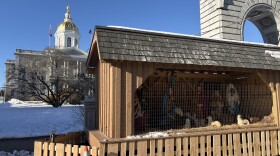Winter is almost here, and for those who heat their homes with wood, that means firing up the stove.
At the beginning of the season, Cody German put an ad on Craigslist for firewood. “Seasoned or green, oak or pine,” says the ad, with different prices per cord, and an additional fee if he delivers it himself.
“Economy's slow, I ain't got much work going on right now, and this is just a way to make ends meet, get by,” German says.
It's a very small operation – just German, harvesting trees from the ten acres behind his Raymond home, splitting it by hand and stacking it to dry.
“I started with about four cords of oak and about three cords of pine,” he says, “but it's been going fairly quick this time of season.”
Small-scale firewood sellers have been filling higher demand for years. Census data from 2010 show a significant increase in the number of wood-heated households. And while no one's officially kept track of firewood use for the last three years, the high demand seems to continue, says Sarah Smith, Forest Industry Specialist at the University of New Hampshire's Cooperative Extension.
“When the price of oil spikes up, people react,” she explains, “and then also the economic downturn, people's inability to afford fuel for their homes,” has led to more people using firewood.
That increased demand has been good news for anyone with a pickup truck and a chainsaw, looking to supplement their income.
Smith says that can make things tricky for buyers. “We don't keep lists of who to buy firewood because by its nature it's a very transient population.” She notes the vast majority of wood sellers seem to be honest, since most complaints are about the same, repeat offenders.
But it's a hard industry to regulate. A stacked cord always comes out to 128 cubic feet, but Smith says other claims are much harder to confirm. For example, seasoned wood should be 20%-30% moisture, while dry should be less than 20%. Proving that is complicated, requiring a special meter, or baking a piece of wood in an oven to see how much moisture weight is lost.
In other words, Smith says, if you can't tell for yourself from appearance and heft whether wood is adequately dry, it's best to just ask friends and neighbors who they buy their wood from.
But not all firewood outfits operate on word of mouth.
The Ossipee Mountain Land Company operates on 15 thousand acres and sells 6 thousand cords a year. From digital monitors in the garage-size kilns where the wood is dried, to machinery that sorts the wood into ¾ cubic-foot bundles for shrinkwrapping, this operation is anything but homespun.

“It's a different animal,” says Jeffery Coombs, the owner and manager of the Ossipee Mountain Land Company. “This is really kind of a manufacturing business, the way we do it here.”
He says the product is different, too – what he calls “mood wood,” sold at supermarkets and hardware stores, rather than as a main source for winter-long home-heating.
But the process does produce a few cords a day of irregularly shaped pieces, and that gets sold in bulk to wood-heated homes. It's already been kiln-dried, and it's all carefully measured out before delivery. “We've never in 25 years had one complaint that someone didn't get enough wood,” Coombs says.
Still, no industry is perfect.
“In the last fiscal year we had 22 actual written complaints that came into our department, and that's been pretty much about that pace for some time,” says Jeff Wentworth, an investigator for the Division of Weights and Measures at the Department of Agriculture.
He attributes most complaints to ignorance on the part of buyers and newer sellers alike. For that reason, the Division of Weights and Measures is trying to get more firewood information out via their website, and by holding seminars with the UNH Extension and other organizations. Wentworth says he especially hopes new, small-scale wood sellers will take the proper steps.
Back in Raymond, Cody German says he didn't know about those resources, but is happy to hear the information is available. He's already been following some of the recommendations, like stacking all of his wood himself to know how much he has, and to be able to prove it to buyers.
Above all, German says he's happy there's demand for firewood. “I'm just grateful to be doing it,” he reflects. “I'm blessed to have these woods and have the opportunity to make a little extra money.”
As long as demand is high, it looks like firewood will keep warming buyers and sellers alike.







